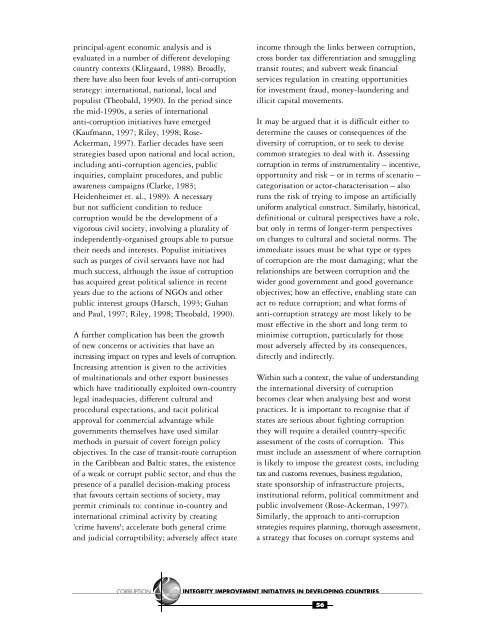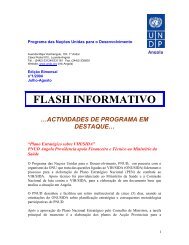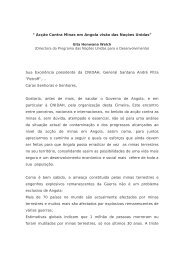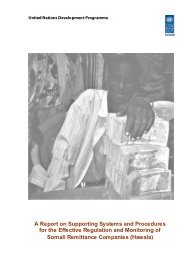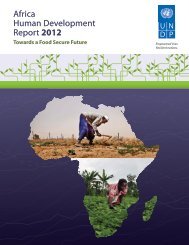CORRUPTION AND ANTI-CORRUPTION STRATEGIES ... - UNDP
CORRUPTION AND ANTI-CORRUPTION STRATEGIES ... - UNDP
CORRUPTION AND ANTI-CORRUPTION STRATEGIES ... - UNDP
Create successful ePaper yourself
Turn your PDF publications into a flip-book with our unique Google optimized e-Paper software.
principal-agent economic analysis and is<br />
evaluated in a number of different developing<br />
country contexts (Klitgaard, 1988). Broadly,<br />
there have also been four levels of anti-corruption<br />
strategy: international, national, local and<br />
populist (Theobald, 1990). In the period since<br />
the mid-1990s, a series of international<br />
anti-corruption initiatives have emerged<br />
(Kaufmann, 1997; Riley, 1998; Rose-<br />
Ackerman, 1997). Earlier decades have seen<br />
strategies based upon national and local action,<br />
including anti-corruption agencies, public<br />
inquiries, complaint procedures, and public<br />
awareness campaigns (Clarke, 1983;<br />
Heidenheimer et. al., 1989). A necessary<br />
but not sufficient condition to reduce<br />
corruption would be the development of a<br />
vigorous civil society, involving a plurality of<br />
independently-organised groups able to pursue<br />
their needs and interests. Populist initiatives<br />
such as purges of civil servants have not had<br />
much success, although the issue of corruption<br />
has acquired great political salience in recent<br />
years due to the actions of NGOs and other<br />
public interest groups (Harsch, 1993; Guhan<br />
and Paul, 1997; Riley, 1998; Theobald, 1990).<br />
A further complication has been the growth<br />
of new concerns or activities that have an<br />
increasing impact on types and levels of corruption.<br />
Increasing attention is given to the activities<br />
of multinationals and other export businesses<br />
which have traditionally exploited own-country<br />
legal inadequacies, different cultural and<br />
procedural expectations, and tacit political<br />
approval for commercial advantage while<br />
governments themselves have used similar<br />
methods in pursuit of covert foreign policy<br />
objectives. In the case of transit-route corruption<br />
in the Caribbean and Baltic states, the existence<br />
of a weak or corrupt public sector, and thus the<br />
presence of a parallel decision-making process<br />
that favours certain sections of society, may<br />
permit criminals to: continue in-country and<br />
international criminal activity by creating<br />
'crime havens'; accelerate both general crime<br />
and judicial corruptibility; adversely affect state<br />
income through the links between corruption,<br />
cross border tax differentiation and smuggling<br />
transit routes; and subvert weak financial<br />
services regulation in creating opportunities<br />
for investment fraud, money-laundering and<br />
illicit capital movements.<br />
It may be argued that it is difficult either to<br />
determine the causes or consequences of the<br />
diversity of corruption, or to seek to devise<br />
common strategies to deal with it. Assessing<br />
corruption in terms of instrumentality – incentive,<br />
opportunity and risk – or in terms of scenario –<br />
categorisation or actor-characterisation – also<br />
runs the risk of trying to impose an artificially<br />
uniform analytical construct. Similarly, historical,<br />
definitional or cultural perspectives have a role,<br />
but only in terms of longer-term perspectives<br />
on changes to cultural and societal norms. The<br />
immediate issues must be what type or types<br />
of corruption are the most damaging; what the<br />
relationships are between corruption and the<br />
wider good government and good governance<br />
objectives; how an effective, enabling state can<br />
act to reduce corruption; and what forms of<br />
anti-corruption strategy are most likely to be<br />
most effective in the short and long term to<br />
minimise corruption, particularly for those<br />
most adversely affected by its consequences,<br />
directly and indirectly.<br />
Within such a context, the value of understanding<br />
the international diversity of corruption<br />
becomes clear when analysing best and worst<br />
practices. It is important to recognise that if<br />
states are serious about fighting corruption<br />
they will require a detailed country-specific<br />
assessment of the costs of corruption. This<br />
must include an assessment of where corruption<br />
is likely to impose the greatest costs, including<br />
tax and customs revenues, business regulation,<br />
state sponsorship of infrastructure projects,<br />
institutional reform, political commitment and<br />
public involvement (Rose-Ackerman, 1997).<br />
Similarly, the approach to anti-corruption<br />
strategies requires planning, thorough assessment,<br />
a strategy that focuses on corrupt systems and<br />
<strong>CORRUPTION</strong>& INTEGRITY IMPROVEMENT INITIATIVES IN DEVELOPING COUNTRIES<br />
5 6


